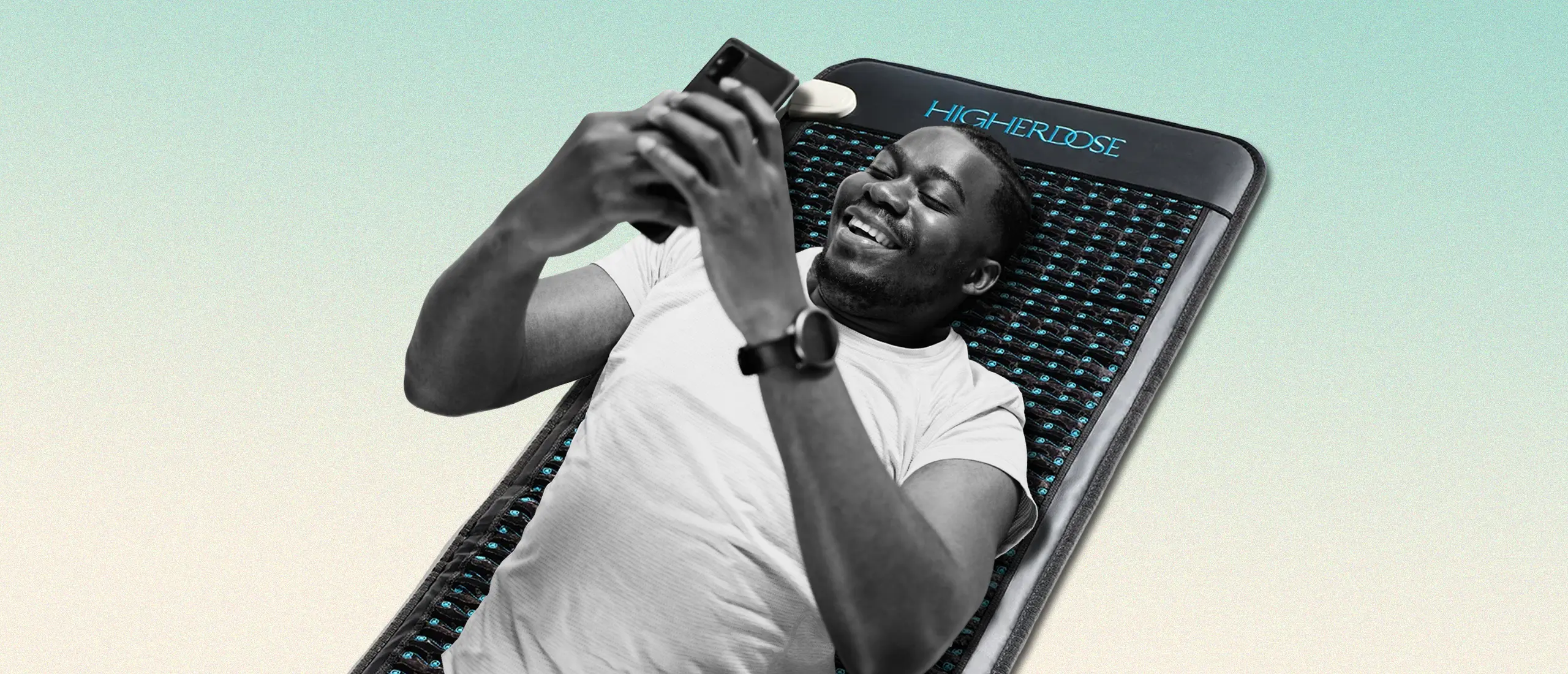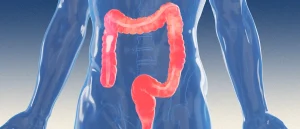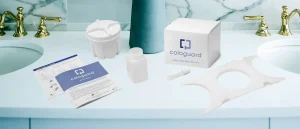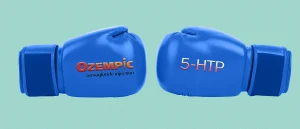3 Science-Backed PEMF Mat Benefits
- By Kelsey Kloss
- March 21, 2024
PEMF therapy has been around for a while, but the industry is expected to grow in the upcoming years—especially as more celebrities and athletes continue to pick up the alternative pain-relief treatment. In fact, market research estimates the PEMF industry will expand to $581.51 million in 2028 (up from $369.52 million in 2022) (1).
Pulsed electromagnetic field therapy (PEMF) is a mouthful term for the non-invasive use of electromagnetic fields that induce electrical microcurrents into the entire body, or locally to target specific tissues. It’s been explored as a potential therapy for pain, bone healing, depression, osteoporosis, and more (2).
Despite the fact that PEMF has been used for over a century, debate around its clinical use continues to stir within the scientific community. Some research shows that low-frequency PEMF therapy is no more effective than a placebo in relieving symptoms like fatigue, depression, or muscle pain in people with specific conditions like relapsing-remitting multiple sclerosis or muscle pain caused by low blood flow (3) (4).
Many who use PEMF therapy, however, report a wide variety of benefits. For instance, it improves circulation and recharges cells, says Lorri Lankiewicz, D.P.T., who has used PEMF mat therapy for years. “It can benefit those who have any type of strains, sprains, chronic low back issues or neck issues, or even acute issues. It’s also great for keeping circulation moving.”
Here’s what to expect if you check out PEMF therapy—plus, the best mats to buy.
About the Experts
Lorri Lankiewicz, D.P.T., president of Fyzical Therapy & Balance Centers in Butler, Pennsylvania. Lankiewicz focuses on integrative health that keeps physical therapy at its core.
Sarav Shah, M.D., co-chief of Orthopaedic Sports medicine at New England Baptist Hospital in Massachusetts. Shah focuses on advancements in multidisciplinary clinical care, research and innovation, education, and medical staff development.
What is PEMF Therapy?
If you decide to try PEMF therapy, here’s what to expect: First, plug the mat into an outlet. Next, lie down on what looks like a thick yoga mat (it may have straps attached to target small surface areas of your body). Then, pulsed electrical currents are generated through the coils in the mat, which increase the energy flow into your system. You won’t really feel anything, but you might hear the frequency, which can sound like a gentle ticking.
“That electromagnetic frequency alters blood flow in a positive way,” says Lankiewicz. “For instance, BEMER PEMF mats are classified as an FDA II cleared medical device because the research completed by BEMER proved that the patented signal temporarily improves blood flow in healthy muscles, which is vital for optimal function.”
Electromagnetic energy is ready and available to support good work in the human body—that’s why we health professionals can record heart and brain signals using long-standing, standard medical tests like EKGs and EEGs. Scientists have found that charging up your cells’ mitochondria can provide health benefits, since natural electromagnetic fields are complementary to your body’s normal functions (5).
“The earth itself has EMFs that can affect the biological charge of a cell and, therefore, result in a biological change, such as removing toxins from a cell by increasing its activity,” says Lankiewicz.
Frequency in PEMF therapy is measured in Hertz (Hz), or the number of waves per second.
“PEMFs can vary widely in frequencies, waveforms, harmonics, and duty cycles,” says Sarav Shah, M.D. “The most effective results in clinical use were found with ultra low frequency.”
Research suggests that PEMFs at a weak intensity and low frequency (from 1 Hz up to 100 Hz) are most effective for resolving pain (6). In comparison, the frequency of electrical currents in U.S. households used to power your home is 60 Hz (7)—but no sweat, you don’t have to worry about getting zapped if you use PEMF therapy correctly.
PEMF therapy isn’t a one-and-done therapy. Typically, repeated treatment sessions are needed. Those with chronic conditions may need longer treatment plans (5).
Those who tend to do well with PEMF therapy have mild to moderate symptoms of disease, as well as those who don’t have many additional health issues, says Shah.
Benefits of PEMF Mats
Lankiewicz says some of the benefits of PEMF mats comes from their ability to increase blood flow and increase energy throughout your body.
“When we have more energy going to our cells, all kinds of good things start to occur,” Lankiewicz says. “Increased energy and circulation are the keys to healthy cells—when we have healthy cells, we have a healthy life. If you were to use a blood flow doppler while a person is on a PEMF mat, it would show an increase in blood flow.”
While handheld PEMF devices deliver electromagnetic waves to targeted areas of your body, PEMF mats are a leading tool for PEMF therapy since they’re easy to use and store. Here’s what science suggests PEMF mats can do.
Decreased pain
PEMF therapy has been found to lower pain and increase mobility in middle-aged adults with lower back pain (8) and reduce discomfort in those with patellofemoral pain syndrome (a type of knee pain) when combined with exercises (6).
“There is good science in support of PEMF as a legitimate pain management strategy,” says Shah, adding that the therapy can change how cells in your joints and other parts of the body respond to nitric oxide-related signals (which play a role in things like blood flow). “This mechanism could promote the resolution of pain by accelerating the removal of inflammatory substances.”
Improved mood
PEMF mats can potentially benefit your brain, too. One study found that eight weeks of PEMF therapy provided significant improvements in depressive symptoms—with about half of participants with non-chronic depressive episodes and 28 percent of those with chronic episodes seeing at least a 50 percent drop in symptoms (9).
Better sleep
PEMF therapy could even help you catch more z’s. Research suggests if you wake up frequently at night to use the bathroom, using electromagnetic therapy in addition to medication (in this particular study, Oxybutynin was used) can improve sleep quality, overall quality of life, and reduce night time toilet visits more than medication alone (10).
The Best PEMF Mats to Buy
If you’re in the market for a PEMF mat, think about safety features, durability, customization options, certification and approvals, and reviews from those who have tried the product.
“A quality mat should have built-in, automatic shut-off mechanisms to prevent overheating and excessive exposure to PEMF,” Shah says. “Look for mats that have been tested and certified by regulatory groups for safety and effectiveness.”
A quality PEMF mat should come with the ability to adjust intensity levels and frequency, and it should be able to withstand regular use without wear and tear.
Frequently Asked Questions
Are there any side effects of PEMF therapy?
PEMF mats are considered a low-risk way to receive potential health benefits like lowered pain and improved sleep. Some people may experience mild side effects like headache or nausea, but these symptoms usually go away on their own (11).
“Research has demonstrated that PEMF therapy is safe, with no significant side effects associated with the therapy,” Shah says.
Who shouldn’t use PEMF mats?
If you have an infection or fever, PEMF therapy could also make symptoms worse, so skip it when you’re sick.
People with pacemakers or electrical implants should also avoid it, says Shah. “The electromagnetic field could interfere with the functioning of these devices.”
Why do some mats have an infrared feature?
Infrared is sometimes combined with PEMF therapy. Both therapies stimulate energy production in the cells, but infrared light therapy does this through specific light waves (12).
Research suggests benefits of infrared therapy also include decreased pain in people who have musculoskeletal disorders or fibromyalgia (13).
How often should you use PEMF mats?
This will depend on the type of mat and the frequency you use, but consistency is key for PEMF therapy.
“For a mat like BEMER, the recommendation is to use it for eight minutes twice per day, so morning and night,” says Lankiewicz.
References
1. Stratview Research. Global Pulsed Electromagnetic Field Therapy Devices Market Size, Share, Trend, Growth Opportunities & Competitive Analysis: 2023-2028.
2. Flatscher J, et al. (2023). Pulsed Electromagnetic Fields (PEMF)—Physiological Response and Its Potential in Trauma Treatment.
3. Granja-Domínguez A, et al. (2022). Effects of pulsed electromagnetic field therapy on fatigue, walking performance, depression, and quality of life in adults with multiple sclerosis: a randomized placebo-controlled trial.
4. Szemerszky R, et al. (2018). No effect of a pulsed magnetic field on induced ischemic muscle pain. A double-blind, randomized, placebo-controlled trial.
5. Long Island Spine Rehabilitation Medicine. Long Island PEMF Therapy.
6. Paolucci T, et al. (2020). Electromagnetic Field Therapy: A Rehabilitative Perspective in the Management of Musculoskeletal Pain – A Systematic Review.
7. DJT Electrical Training. Frequency – what it is, and why it’s important.
8. Abdelhalim N, et al. (2019). Short-Term impacts of pulsed electromagnetic field therapy in middle-aged university’s employees with non-specific low back pain: A pilot study.
9. Larsen ER, et al. (2020). Transcranial pulsed electromagnetic fields for treatment-resistant depression: A multicenter 8-week single-arm cohort study.
10. Chen SH, et al. (2022). The effect of electromagnetic field on sleep of patients with nocturia.
11. KOH Physical Therapy Lab. Pulse Electromagnetic Field Therapy.
12. Heim Regenerative Medicine Center. Benefits of Pulsed Electromagnetic Field (PEMF).
13. Tsagkaris C, et al. (2022). Infrared Radiation in the Management of Musculoskeletal Conditions and Chronic Pain: A Systematic Review.












